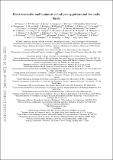| dc.contributor.author | Masui, Kiyoshi | |
| dc.date.accessioned | 2022-04-27T18:01:58Z | |
| dc.date.available | 2022-04-27T18:01:58Z | |
| dc.date.issued | 2022-03 | |
| dc.identifier.uri | https://hdl.handle.net/1721.1/142155 | |
| dc.description.abstract | Fast radio bursts (FRBs) are extragalactic radio flashes of unknown physical
origin. Their high luminosities and short durations require extreme energy
densities, like those found in the vicinity of neutron stars and black holes.
Studying the burst intensities and polarimetric properties on a wide range of
timescales, from milliseconds down to nanoseconds, is key to understanding the
emission mechanism. However, high-time-resolution studies of FRBs are limited
by their unpredictable activity levels, available instrumentation and temporal
broadening in the intervening ionised medium. Here we show that the repeating
FRB 20200120E can produce isolated shots of emission as short as about 60
nanoseconds in duration, with brightness temperatures as high as $3\times
10^{41}$ K (excluding relativistic effects), comparable to `nano-shots' from
the Crab pulsar. Comparing both the range of timescales and luminosities, we
find that FRB 20200120E observationally bridges the gap between known Galactic
young pulsars and magnetars, and the much more distant extragalactic FRBs. This
suggests a common magnetically powered emission mechanism spanning many orders
of magnitude in timescale and luminosity. In this work, we probe a relatively
unexplored region of the short-duration transient phase space; we highlight
that there likely exists a population of ultra-fast radio transients at
nanosecond to microsecond timescales, which current FRB searches are
insensitive to. | en_US |
| dc.language.iso | en | |
| dc.publisher | Springer Science and Business Media LLC | en_US |
| dc.relation.isversionof | 10.1038/s41550-021-01569-9 | en_US |
| dc.rights | Creative Commons Attribution-Noncommercial-Share Alike | en_US |
| dc.rights.uri | http://creativecommons.org/licenses/by-nc-sa/4.0/ | en_US |
| dc.source | 599440 | en_US |
| dc.title | Burst timescales and luminosities as links between young pulsars and fast radio bursts | en_US |
| dc.type | Article | en_US |
| dc.identifier.citation | Masui, Kiyoshi. 2022. "Burst timescales and luminosities as links between young pulsars and fast radio bursts." Nature Astronomy, 6 (3). | |
| dc.contributor.department | MIT Kavli Institute for Astrophysics and Space Research | |
| dc.contributor.department | Massachusetts Institute of Technology. Department of Physics | |
| dc.relation.journal | Nature Astronomy | en_US |
| dc.eprint.version | Original manuscript | en_US |
| dc.type.uri | http://purl.org/eprint/type/JournalArticle | en_US |
| eprint.status | http://purl.org/eprint/status/NonPeerReviewed | en_US |
| dc.date.updated | 2022-04-27T17:57:06Z | |
| dspace.orderedauthors | Nimmo, K; Hessels, JWT; Kirsten, F; Keimpema, A; Cordes, JM; Snelders, MP; Hewitt, DM; Karuppusamy, R; Archibald, AM; Bezrukovs, V; Bhardwaj, M; Blaauw, R; Buttaccio, ST; Cassanelli, T; Conway, JE; Corongiu, A; Feiler, R; Fonseca, E; Forssén, O; Gawroński, M; Giroletti, M; Kharinov, MA; Leung, C; Lindqvist, M; Maccaferri, G; Marcote, B; Masui, KW; Mckinven, R; Melnikov, A; Michilli, D; Mikhailov, AG; Ng, C; Orbidans, A; Ould-Boukattine, OS; Paragi, Z; Pearlman, AB; Petroff, E; Rahman, M; Scholz, P; Shin, K; Smith, KM; Stairs, IH; Surcis, G; Tendulkar, SP; Vlemmings, W; Wang, N; Yang, J; Yuan, JP | en_US |
| dspace.date.submission | 2022-04-27T17:57:10Z | |
| mit.journal.volume | 6 | en_US |
| mit.journal.issue | 3 | en_US |
| mit.license | OPEN_ACCESS_POLICY | |
| mit.metadata.status | Authority Work and Publication Information Needed | en_US |
